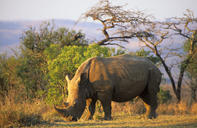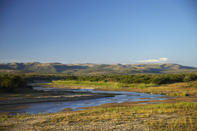History
The area where the reserve now thrives was first inhabited by Stone Age settlers. The grounds were also part of the early Zulu kingdom royal hunting terrain. Hunting was popular in the area during the 1840s, when European settlers travelled from the Cape to plunder the region for animal skins and rhino horn.

Due to extensive hunting, various species of animals were on the verge of extinction. The Hluhluwe and uMfolozi Game Reserves were proclaimed in 1895 in an effort to save the wildlife that called the region home. Hluhluwe-Imfolozi was originally three separate reserves that joined under its current title in 1989.
During the 1950s, the park ran Operation Rhino, a conservation initiative that saved the white rhino from extinction. It was the birthplace of rhino conservation in the country as we know it today. The animals were under the protection of the then Natal Parks Board (now known as Ezemvelo KZN Wildlife), and in the 1960s the population grew to a sufficient amount to allow the animals to be transported to other reserves in the country.
Geography

The Umfolozi area is situated between the two Umfolozi Rivers, where they divide into the Mfolozi emnyama ('Black Umfolozi') to the north and the Mfolozi emhlophe ('White Umfolozi') to the south. This section of the park ranges from lowlands and river beds to steep landscapes, with wide and deep valleys.
The Hluhluwe region is hilly with high ridges that supports coastal scarp forests, and is rugged and mountainous with forests and grasslands. There was a natural movement of game between the two areas due to the functioning ecosystems working together. The park's vegetation is classified as Zululand Lowveld and Northern Zululand Thornveld.
The park is generally hot in summer and mild to cool in winter with some cold spells. There is a good network of dirt roads in the park. The only part of the park excluded is the Wilderness area, where there are only a few trails for walking tours.